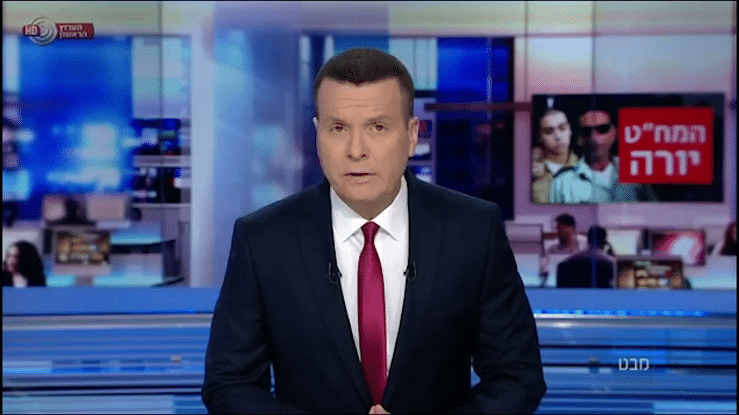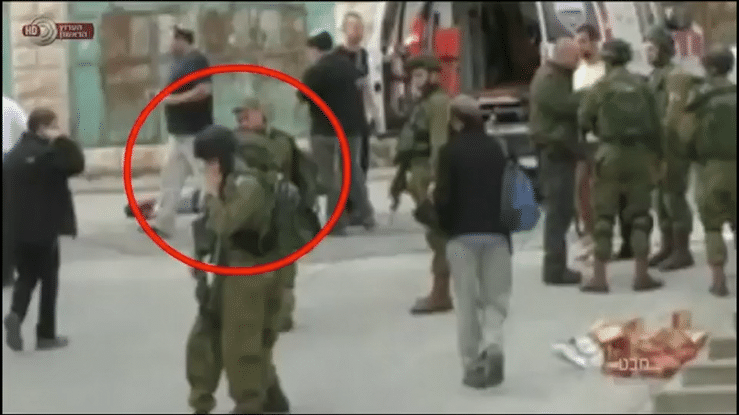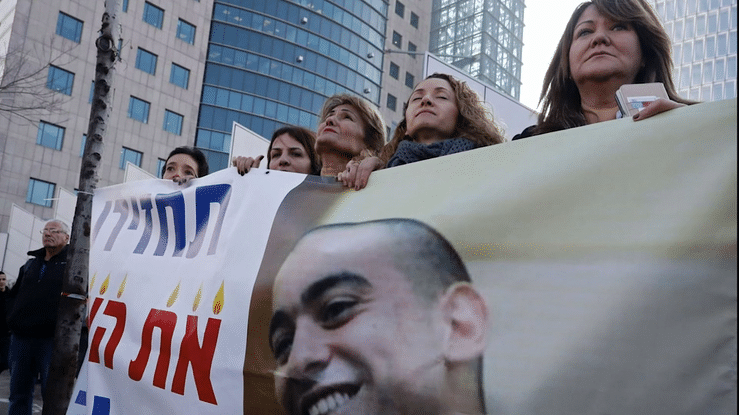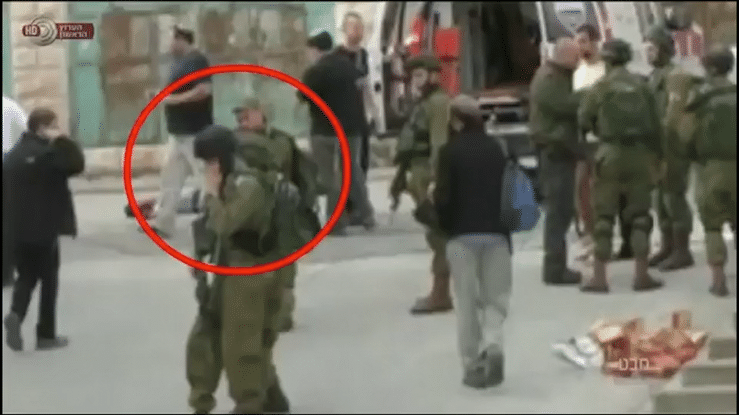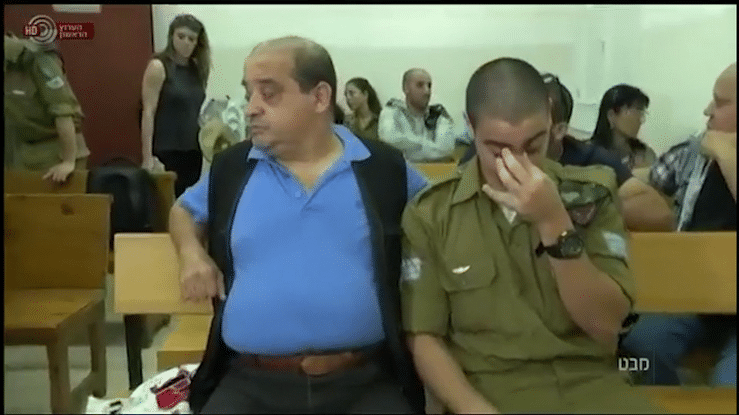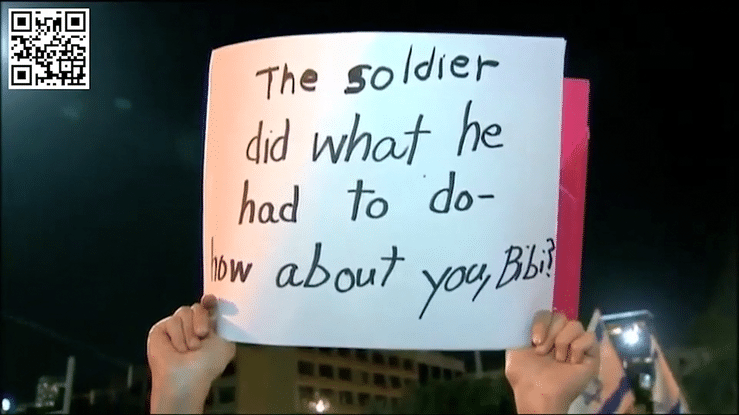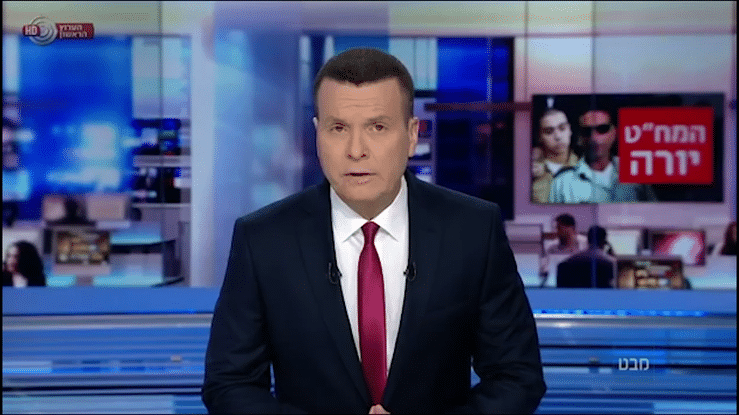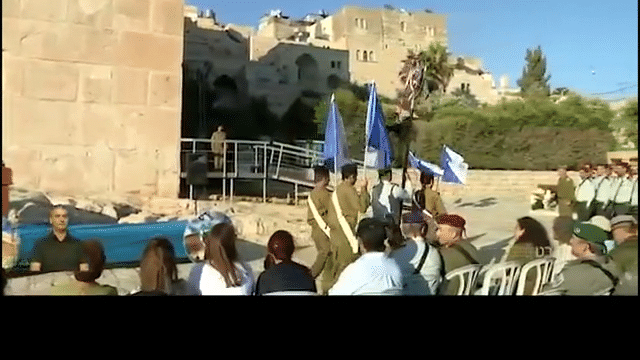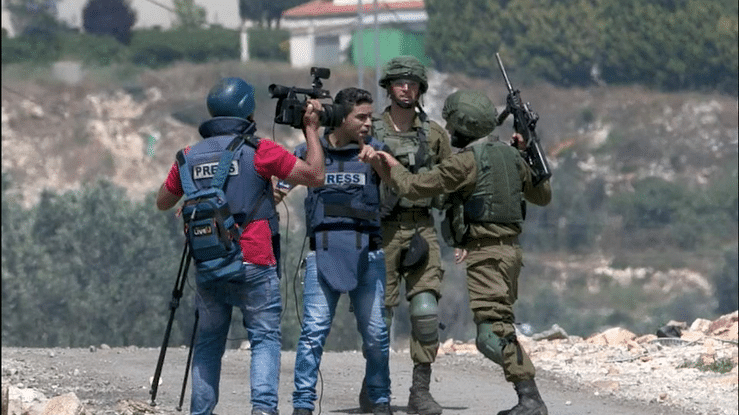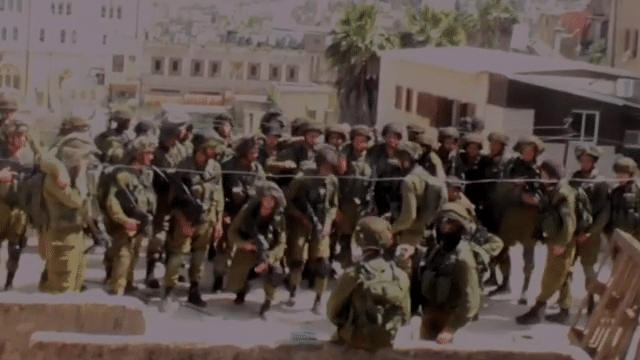Spectacle as Camouflage: How the IDF Learned to Stop Worrying and Love Video Activism
Daniel Mann
On March 24 of 2016, an incident was caught on camera that would quickly spark an international controversy. That morning Imad Abu Shamsia, a Palestinian resident in Hebron, heard gunshots outside of his home located near the Jewish settlement at the heart of the Palestinian city. Abu Shamsia had been filming the daily frictions between IDF (Israel Defense Forces) soldiers and the Palestinian residents of Hebron for years. “I live just ten meters from the place,” Abu Shamsia later testified, “I heard gunshots and immediately rushed outside with the camera in hand.”{1} Familiar with the task, Abu Shamsia was quick to find a position from which to film the unfolding event in the junction below. Minutes before Abu Shamsia’s camera started recording the event, the assailant—Abed al Fatah a-Sharif—attacked an Israeli soldier with a knife and injured him. A-Sharif was then shot with six live bullets. Gravely wounded, a-Sharif was still alive when the Israeli soldiers, together with local Jewish settlers, huddled around his body, unsure how to proceed. It was then that the incident took an unexpected turn: one of the soldiers on the scene—a sergeant by the name of Elor Azaria—took matters into his own hands. After assisting with the evacuation of the wounded soldier, Azaria handed his helmet over to a nearby soldier, approached a-Sharif, cocked his rifle and shot him in the head at point-blank range. He died on the spot.
B’Tselem, “IDF Soldier Executes Wounded Palestinian man,” posted on Youtube, March 24, 2016.
Hours later, the three-minute video was already circulating on social media platforms. Instantly going viral, the killing was there for all to see. The rapid circulation of the video was the fuel that instigated the legal action taken by the IDF military police against the soldier. Once the video was out there—posted, shared and reshared—nothing could have restrained its rapid circulation. Abu Shamsia later explained his decision to send the camera’s memory card to B’Tselem, an Israeli NGO devoted to documenting violations of human rights in the Israeli-occupied territories, as a way of ensuring that the original file would not be immediately discredited.{2} Anticipating the IDF’s incentive to foil the distribution of the video and scrutinize its credibly by any means, B’Tselem released the video within hours.
Various media outlets stressed that the recording of the extrajudicial killing in Hebron reaffirmed the capacity of photographic images to expose abuses of power by IDF soldiers that otherwise could have been kept hidden. Undoubtedly, the video provides a solid example of the utility of filmed evidence in the procedure of demanding accountability for grave violations of human rights against the Palestinian population in the West Bank. However, this function of visual media is often over-emphasized, occluding other less perceptible operations that complicate the agency of visual media. Rather than asking how visual media are appropriated by colonized subjects, I want to shed light onto economies of image circulation that determine which images can threaten the modus operandi of the state, and which merely sustain its prevailing code of conduct. In what might seem counterintuitive, I suggest that the video, and the process of incriminating the seemingly “rogue soldier,” speaks less to the ethico-legal assertions made possible through media, and more to the myriad ways in which the military protects itself from the increasingly mediatized space of the occupied territories. Focusing on the video of the extrajudicial killing and the trial that followed, the question of how the Israeli state protects itself from dissident media in a hyper-visible space resurfaces with new urgency. It seems that the age-old tactics of image containment, such as restricting the use of cameras or censoring images, are no longer adequate. Particularly in the Occupied Palestinian Territories, where soldiers are tasked with policing the civil population, and with the sheer ubiquity of mobile phone cameras and social media, visibility is inevitable. In such circumstances, the very dichotomy of visibility and invisibility should be thoroughly reconsidered by taking into consideration the excess of image-data and the deluge of images that appear on our screens. Surfacing from the video of the killing in Hebron is an unlikely question that pertains to the capacity of visual technologies not merely to mobilize legal accountability, but also to eclipse it. Whereas the video of the killing in Hebron accentuates the crucial role of cameras held by Palestinians as disenfranchised subjects, I argue here that it should be thought of within a wider context of data circulation and the solid stream of information that saturates our databases and screens, which in turn, destabilizes the binary logic that separates the emancipatory potential of visual media and their repressive, regulatory, and containing ends.
The overabundance of visual documents of armed conflict has been long considered as another form of obfuscation. In his seminal essay “Mobilizing Shame,” Thomas Keenan unpacks the role of shaming in which the suspension or absence of the law is used as a tactic by the international human right movements.{3} Mobilizing shame, for Keenan, means deploying affectivity in visual evidence where legal accountability does not hold. This belief in the power of the photographs and oral testimonies however can lead to an impasse, particularly in certain conflicts in which violent acts are no longer hidden and obscured. Turning the power of representations of violence inside out, Keenan suggests that exposure could in fact operate to erase:
The dark side of revelation is overexposure. Sometimes we call it voyeurism, sometimes compassion fatigue, sometimes the obscenity of images or ‘‘disaster pornography.’’ If shame is about the revelation of what is or ought to be covered, then the absence or failure of shaming is not only traceable to the success of perpetrators at remaining clothed or hidden in the dark. Today, all too often, there is more than enough light, and yet its subjects exhibit themselves shamelessly, brazenly, and openly.{4}
The very category of shame, for Keenan, is inadequate in thinking about the role of media in contemporary armed conflicts. The invocation of shame relies on the problematic notion that if the perpetrators are “caught in the act,” shame might be their final punishment. What if, asks Keenan, the so-called shameful act performed by soldiers or police is routinized—no longer considered by them as something worth hiding? Or, asked differently, what if shame is mobilized by the perpetrators themselves to isolate particular incidents, excluding certain acts as extreme, and in so doing, allowing the routine to continue uninterrupted? What if, due to the sheer excess of images and data, confusion takes over and the ability to see and point a finger at the shameful moment becomes severely hampered?
I argue here that reconsidering the ability of representations to mobilize shame, and indeed accountability, requires a closer look into the media practices utilized to document armed conflict. While images circulate rapidly via social media platforms, the circumstances of their production and the economy of their reach are rarely considered. Once we move beyond what the video frames and the fine details within, we inevitably pass into a realm governed by a patchwork of forces that together determine what is revealed, and what remains obscure; what is exceptional and what is utterly mundane. It seems as though images are merely the sharp edges of a more expansive constellation that merges bodies, technologies, and modes of circulation. Unlike the affective quality of one particular video, such constellations can potentially expose how media can either demand personal liability for abuses of power by state actors, or in other cases, sustain their uninterrupted continuation. The video of the killing of Abed al Fatah a-Sharif necessitates that we answer two urgent questions: What kinds of political impunity are erected against visual documents? Can a single image reveal a more endemic structural violence, and if not, how can this violence be made apparent?
****
Selective Enforcement
These questions are not merely a theoretical exercise; they were in fact implicitly articulated by the soldier’s defense lawyers during his controversial trial. By May of 2016, the soldier’s trial had begun, and with it, a deep cut divided the Israeli public into two camps: the first, consisting of thirty percent of the public, deemed his act unlawful and condemned it wholeheartedly. But the second camp, to which more than forty-seven percent of the Israeli public belonged, supported Azaria and justified his extreme measures.{5} By refusing to accept the soldier’s act as a crime, numbness and indifference among the bystanders was sustained and, simultaneously, an avoidance of guilt was made possible. When an IDF policeman presented the footage to Azaria during an internal enquiry, he instinctively stated: “I do not believe what I see.”{6} Dormant in his statement is not only a desperate attempt to shake off his personal accountability, but a reliance on the deep suspicion towards images as truth-claims. Although obscene, Azaria’s dismissal of the video is worth exploring, not so much as an indictment towards the video’s authenticity, but as a statement targeted at the inherent limitation of representations.
According to the protocols of the court ruling, the video was submitted as evidence under the scrutiny of the soldier’s defense, which took the effort to discredit it as unreliable and deceptive.{7} Following a forensic examination, an expert confirmed that the video was not tampered with in any way. Frame-by-frame, the footage was dissected with the purpose of exposing the fine details of the incident. From the analysis of the video it was evident that Abed al Fatah a-Sharif, the injured assailant, did not pose any threat to the soldiers around, and therefore was already incapacitated when Azaria shot him from point blank range. The claim that Azaria sensed immediate danger, and therefore shot Al-Sharif to thwart a potential attack was simply unfounded. One after the other, the arguments presented by the soldier’s defense were deflated by a careful examination of the visual document. Come January 2017, Azaria was convicted of manslaughter by the military court and sentenced for eighteen months in prison.{8}
But the controversy was far from over. The defense attorneys were quick to appeal the conviction at the Supreme Court of Israel. Led by attorney Yoram Sheftel, the team collected evidence that pertain to other events, during which an IDF soldier had shot and killed a Palestinian man.{9} These cases, Sheftel argued, presented similar circumstances to the killing in Hebron. The purpose of the appeal was thus to show that other soldiers were not tried or convicted for their acts. Azaria, claimed the defense, was selected deliberately to be accountable for what others are routinely exempt from. “Other incidents are as severe as the case in question,” claimed the defense, and “In all cases, either the incident was not investigated in the first place, or the soldier was never charged with criminal prosecution.”{10}
The defense appealed for selective enforcement, a legal clause that addresses a situation in which the official enforcing of the law selectively chooses to arrest an individual for acts performed by others alike.{11} Contrary to uniform enforcement, where all violators caught are charged, selective enforcement is used when an individual is singled out from the public to face allegations that others routinely evade. The logic of the appeal was predicated on the argument that the case was far from exceptional. Selectively, the defense attorneys argued, the trial had become a façade that sought to demonstrate the military’s attempt to display values that are regularly disregarded by the IDF. By presenting this argument, the soldier’s defense unleashed a direct attack against the military establishment: rather than focusing on the minute details of the incident, the defense diverted the attention away from the singularity of the incident and onto other similar events that presented comparable circumstances in which an IDF soldier shot and killed an unarmed Palestinian man. Elor Azaria, the defense insinuated, should not carry the burden and legal liability for the code of conduct embedded into the system.
Peculiarly, the evidence submitted to the court was based on a collection of articles compiled by an activist who sought to expose the permissiveness of “Open-Fire Regulations” in the West Bank and the numerous killings exercised by the IDF, which were never investigated (B’Tselem, 2002).{12} According to Jon Brown, ninety-seven percent of internal investigations at the IDF are left unresolved. Beginning with the eruption of the second intifada in 2000 and until 2016, 9,250 Palestinians were killed by IDF fire, 262 of which were investigated by the military police, but only one soldier was convicted of manslaughter.{13} Jon Brown was hired by Azaria’s defense and was put in charge of collecting sufficient evidence of other cases that present similar circumstances. For a brief moment, the soldier’s defense found a common interest with an activist devoted to exposing the abuse of power by the Israeli state. Together, they intended to prove that this particular incident was compatible with a broader pattern of structural violence.
Brown prepared a file that contains fourteen different cases, almost all of which were never documented by any camera. When the files were submitted to the court in May of 2017, they were immediately rejected, mostly due to the lack of visual documents that could support a selective enforcement procedure. Pictures, the court insisted, are the linchpins of incrimination. Or more significantly, if the Israeli court had accepted the argument that the soldier acted according to a normative code of conduct, it would have been forced to admit that the Israeli state exercises extrajudicial killings as part of its military rule in the West Bank. The military court was thus effectively compelled to treat the soldier as a bad apple. Amputating the gangrenous limb would save the body.
By diverting the attention from the singularity of the video to other similar incidents that were never caught on camera, Azaria’s defense lawyers shrewdly invited the public to critically reflect on the role of images in processes of yielding accountability. Deflecting the gaze elsewhere, they implicitly invoked an interrogation into the dominant position of representations in legal procedures of incrimination. The shot executed by Azaria, they argued, should be compared, juxtaposed, superimposed, and imagined against other incidents, even those that lack representation altogether. Although intended to save the murderous soldier from prison, the defense’s argument invited a critical inquest into the ontological status of visual media.
****
The Selective Enforcement of the Visual
Pursuing the defense’s argument means accepting that while visual media are commonly conceived through their ability to reveal and expose, they can also erase and obfuscate. This duality may seem contradictory, as we rarely think about the existence and circulation of images and data as obstacles for truth claims, nor do we take into consideration the significance of circulation itself as a threat to the potential evidentiary status of an image. Instead, we tend to look at an image, focusing on the content and detail within the frame, from which we can extract our narratives. At stake in this urgency to see, decipher, and forensically analyze, is a legal scopophilia that diffuses the substantial role of circulation in defining a threshold between what can be evidentiary and what will be automatically dismissed. It is these stakes that the defense latched onto during the Azaria trial. Thus, for a brief moment, a single visual document of unlawful killing was used in concert with numerous other violent incidents that were never caught on camera. In the argument of the military court the singularity of the event is conflated between its exceptionality and its availability as a document. In construing the event as “exceptional” the court blurs the deeper patterns of violence that together emerge in less visible forms. Focusing on a spectacular outburst of rage manifested in the split second of a gunshot could thus be complicit with obfuscating the longer, imperceptible persistence of suspended violence that bleeds from the edges of the frame. “Spectacle,” suggests Jared Sexton and Steve Marinot, “is a form of camouflage.”{14}
The frame, writes Judith Butler, “does not simply exhibit reality, but actively participates in a strategy of containment, selectively producing and enforcing what will count as reality.”{15} In this way, Butler also employs the vocabulary of “selection” and “enforcement” to formulate her critique of images of atrocities. The primacy of the visual document, stresses Butler, not only represents but also shapes the very reality that it captures.{16} “The frame is always throwing something away,” argues Butler, “always keeping something out, always de-realizing and delegitimating alternative versions of reality, discarded negatives of the official version.”{17} The process of selection inherent in framing a photograph, suggests Butler, is itself a mode of violence. Images are always already more than a represented scene since by virtue of having a frame, and of being framed, the photograph or video implicitly suggests that there is an outside, an exteriority, ever so slightly beyond our vision. Isn’t that what the legal defense intended for igniting the imagination to compensate for the lack of images that render other similar incidents visible? Could Butler’s cautionary critique amount to a warning against a visual selective enforcement that elevates a singular image, without delicately examining the structural lacks and lacunae that complicate the relationship between a given representation and the circumstances of its production? Not unlike the strategy adopted by the soldier’s legal advisor, Butler redirects our inquiry to the periphery, to articulate an appeal against the selective enforcement of a singular image. Against the selective enforcement of images, the meaning of an image should be redefined by repositioning it into a broader assemblage of data. From this assemblage, the economy of circulation that separates the extraordinary and the mundane, the exception and the norm, is gradually put to question.
****
From Representation to Circulation
In the files prepared by Jon Brown for the court, the defense team stated:
The Israeli Army censored the records we obtained. The names of the soldiers were erased from it, and in some of the cases, the locations of the killings were left out. This list is not meant to imprison those who have killed. The real blame is placed on the system. The essence is not the individual soldier, but the establishment.{18}
The argument posed by the defense elicits the dichotomy conjured by the tension between the singular and multiple. The individual soldier, excommunicated due to his unruly behavior against the establishment, is a body politic composed of the many. But does the same spectrum apply to the visual realm? Gathering and comparing documents, juxtaposing different incidents, the defense team of Azaria sought to appeal to a new logic that stems from a montage comprised of partial images.
Georges Didi-Huberman argues that montage can potentially move the gaze away from a given representation and probe into the significance of lack: the lack of evidence or a coherent narrative that could shed light into the procedures employed by the IDF. “The knowledge value could not be intrinsic to one image alone,” writes Didi-Huberman, “on the contrary, it is a question of putting the multiple in motion, isolating nothing, showing the hiatuses and analogies, the inter-determinations and the over-determinations.”{19} Didi-Huberman aims to respond to what he sees as the brutality of reducing history to singularities; to a single document that speaks of a certain violence. “We must respond to this perceptual brutality,” he writes, “by pointing out that the image is neither nothing nor one, nor all, precisely because it offers multiple singularities always perceptible to differences.”{20} Drawing on Didi-Huberman’s argument, one could say that images of atrocities appear with a seductive nature that imbues them with a power to show, and tell, with an aura of truth. But this seeming power must be critically examined. A totalizing conception of an image is bound to fail by either seeing too much—what Didi-Huberman calls an all-image, which stems from a belief that the image can show you everything—or by censoring it altogether, dismissing it as a treacherous copy of the event.{21}
The military institution was invested in convicting Azaria precisely to turn the images of his killing into an exceptional all-image. The motive behind the Israeli army’s insistence on bringing Azaria to court and convicting him of manslaughter was not only to turn his trial into a showcase, but also to isolate the video that caught him red-handed. This act of isolation became a method of immunizing the state against an image milieu that reflects back its own image of violence. In this example the IDF can afford the admission of a singular violent act in order to spare the system itself. The video that catches Azaria “in the act,” could be absorbed by the military complex via labeling the video and the incident as an isolated incident.
Nevertheless, it is crucial to recognize that the isolation of the video/image/event is not the only way in which the IDF can contain the condemning quality of images. After all, there are other strategies to curb the capacity of images to incriminate that which often escapes the eye. An appeal against such isolation essentially means considering the proliferation of sources from which images emanate. The single, incriminating image is gradually replaced with an abundance, which undermines the traditional agency of one visual document. At the core of this strategy is a move from representation to circulation, which for Andrew Hoskins and Ben O’Loghlin is innate to digital media and their capacity to be shared and circulated online. What Hoskins and O’Loghlin call the mediality of images—or the focus on conditions of distribution rather than their specific content—directly affects their power to mobilize reactions and propel an investigation while, at the same time, weakens the impact of a single photograph or video.{22} Mediality refers to how media texts are interwoven into everyday lives; how the continuity and familiarity of these representations interact with everyday media practices.{23}
Against the potential of videos and photographs to expose violations of human rights, the IDF has gradually recognized that the most efficient strategy to defuse the contaminating capacity of viral images is to produce and circulate more image-data that could muddle the single and particularly incriminating image. The shield against exceptional images is made out of numerous other images that together amount to a “scale armour” comprised of various documents. If Didi-Huberman addressed the scarcity of visual images in specific cases where photographs and films could not have been produced due to censorship, confronting the documentation of the armed conflict in the Occupied Palestinian Territories means replacing scarcity with over-abundance.
****
A Counter-Counter Visuality
A closer look at the media strategies employed by the IDF exposes a gradual shift from image censorship to image inundation. In the last decade, the IDF began realizing that the flood of images, emerging from the habitual use of mobile technologies and social media could in fact operate as another mode of visual containment, and even concealment. The IDF gradually adopted techniques of obfuscation as responses to the organized use of visual media by colonized subjects. Practices of filmmaking emerged from modes of nonviolent resistance aimed at gathering international support for the Palestinian struggle towards self-determination.{24} Such practices, cultivated to render life under occupation visible, stem from the unique form of colonization that Israel exercises and the dilemmas that emerges from it: the extension of its sovereignty to the West Bank would confer citizenship on, or at least provide the choice of citizenship to, its Palestinian population and thus would diminish the Jewish majority of Israel. The ongoing expropriation of Palestinian land—both public and private—for the benefit of the Jewish settler population, as well as the neglect and indifference of the Israeli police and military of abuses and attacks on Palestinians by settlers, highlights the duality of the legal and practical circumstances under which Palestinians live in the Occupied Territories.{25} Filmmaking was thus practiced, not only to document events and incidents that take place within that space of exception, but also to compensate for the lack of protection that the law infers on individual Palestinians. This is also the impetus behind Abu Shamsia’s practice of filmmaking. Living in the Hebron, Abu Shamsia began collaborating with the NGO B’Tselem with the purpose of collecting visual evidence.
A decade ago B’Tselem initiated an organized project oriented towards the documentation of life under military rule. In January 2007, the NGO launched its camera distribution project as a video advocacy project focusing on the West Bank and East Jerusalem.{26} The project was devoted to allocating video cameras to Palestinians living in high-conflict areas. One of the core strategies of the project was to distribute cameras to civilians rather than known activists. The purpose of the initiative was to “bring the reality of Palestinians” to the attention of the Israeli and international public, exposing and seeking redress for violations of human rights.
In 2007, the presence of cameras in high-conflict areas presented a new dimension of visibility not known before. Oren Yakobovich, then the director of B’Tselem’s video department, focused on power and transparency:
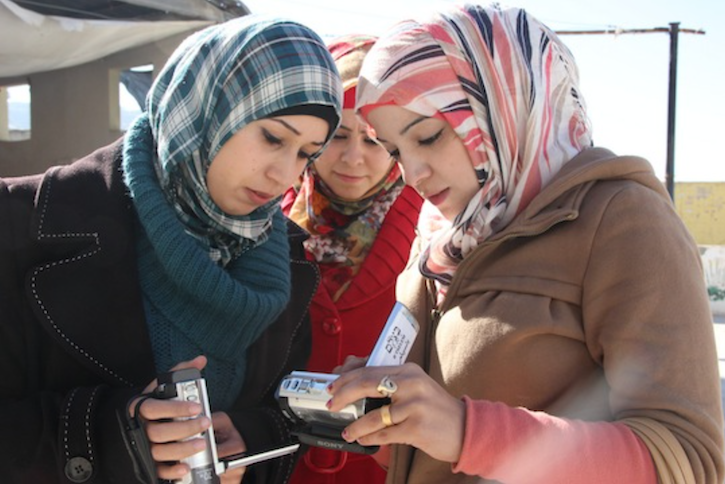 B’Tselem, Atta Najar, Salam Najar and Mi’ad Najar check out the cameras and compare footage in “Women
behind the lens: Palestinians Filming the Occupation,” +972 MAGAZINE, March 8, 2014.
B’Tselem, Atta Najar, Salam Najar and Mi’ad Najar check out the cameras and compare footage in “Women
behind the lens: Palestinians Filming the Occupation,” +972 MAGAZINE, March 8, 2014.
It’s giving power. You know, this word is called “empowerment.” I don’t like this word so much, but I will use it. It’s the children and the kids that are filming. It’s helping to mobilize communities. In Hebron, where the community was destroyed, suddenly they’re filming and they have some kind of an interest in seeing the videos, talking about it. And what I hope to achieve, that everything is going to be filmed, at least in the—there’s going to be a feeling that everything is being filmed, nothing is being done in the dark.{27}
The technological utopianism and the emancipatory tone embraced by B’Tselem in the first years of the project materialized from the firm belief that cameras counterbalance the lack of democratic governance and eventually empower Palestinians. The metaphor of darkness and illumination, employed by the director of the project, is endemic of the agency imbued to visual documents and the perception that sunlight is the best disinfectant.
But where sunlight is bound to expose, it can potentially also burn the eyes. Gradually, the IDF began to experiment with visual strategies that were tailor-made to limit the viral potency of the videos produced by Palestinians, in collaboration with B’Tselem. The partial success of the videos to stimulate the awareness of the international sphere convinced the IDF that the best possible way is to mimic dissident practices.
From 2011, for instance, IDF soldiers were actively encouraged to document the daily encounters with Palestinian resistance in the West Bank. A specially designed project was inaugurated by the IDF to mirror the B’Tselem “shooting back” initiative. The project titled “Documenting Warrior Project” allocated thirty cameras to soldiers deployed in the West Bank. The private Israeli company Elsight “designed special camera units for IDF soldiers who confront the various cameras held by the enemy.”{28} Providing to each of the thirty soldiers a “documentary camera unit,” Elsight announced:
The IDF long understood that the war in the media arena is no less than that conducted in the field (…) The IDF is looking for a comprehensive offering, combining small tactical hardware and advanced state of the art software, which will provide the operational tools to create fast video broadcasting clips from raw video feeds, arriving from the different units, spread across the field.{29}
The emphasis on advanced technologies and technological superiority neglects to recognize that daily habits and practices of image making could be appropriated for operational needs. In other words, while the IDF initially attempted to mirror the “shooting back” project, the superiority of their technologies was rendered superfluous when confronted with the force of habits. The acknowledgement that soldiers carry mobile phone cameras with them as part of their everyday routine was quickly implemented and weaponized by the IDF, replacing a concerted institutional media strategy. By imitating grassroots media, soldiers attempt to defuse the contagious potency of images. Using their own mobile phone as army-issued cameras, soldiers incorporate what initially posed a risk to the authority they enforce.
By 2011 various new practices were adopted by IDF soldiers to challenge the use of cameras by Palestinians. At the time, soldiers had to cope with the cameras that were recording their routine procedures of raiding and searching homes in the West Bank. Subjected to frequent search by soldiers, Palestinians in the West Bank were prepared to film with their own cameras in case their home was to be raided. To mirror the persistent practices of filmmaking undertaken by civilians, soldiers cultivated a new procedure codenamed “mapping.” Mapping involves collecting information during nightly raids into Palestinian homes and gathering visible evidence about the lives and living environments of families in dense urban spaces in East Jerusalem, Hebron, Ramallah, and Jenin.{30} Waking up the family members in the midst of night, lining them up in their pajamas, the soldiers take out a lightweight camera or smartphone to snap photographs of the inhabitants’ faces.
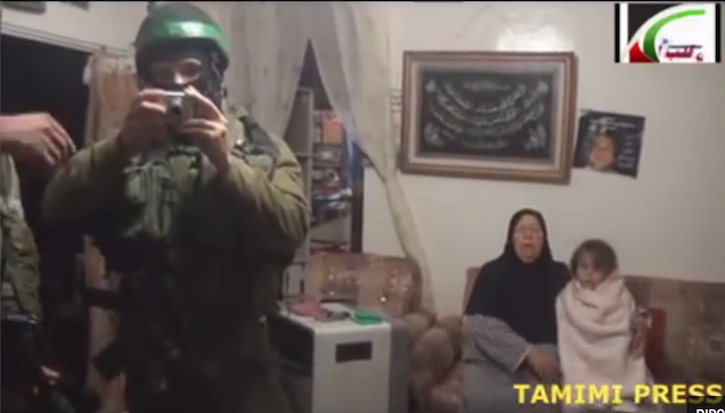 Tamimi Press, Night raid in Nabi Saleh—5 people arrested, Nabi Saleh Solidarity, February 18, 2014.
Tamimi Press, Night raid in Nabi Saleh—5 people arrested, Nabi Saleh Solidarity, February 18, 2014.
The stated purpose of mapping is to deter individuals from taking political action. The logic is such that if ones face is captured as a photograph, he or she is then easily identified by surveillance technologies that frame public spaces and record any suspicious behavior or illegal action such as throwing rocks or demonstrating. “Often,” one soldier recalls, “we erase the files by the end of the day.” Whether surveillance systems actually probe faces from existing archives remains obscure; nevertheless, deleting images does not erase the potential of information to trace back particular subjects and to incriminate the inhabitants of a given household. The influx of image-data accumulating in the military hard drives is meant to disseminate smoke screens of visual data—photographs and videos—that would obscure a single “problematic” video.
Whereas the Palestinians initially began the concerted practice of filmmaking to challenge Israel’s visuality and to collect evidence for judicial purposes, the IDF developed a sort of “counter-counter-visuality” shaped by the attempt to claim back authority and to nourish a “data-fatigue.” To eclipse the potency of dissident media practices, the state gradually begun parroting these practices. Increasingly, the organized efforts by both Palestinians and IDF soldiers were replaced by habits of image production and circulation, inscribed by technologies such as mobile phones and social media. Imperatives were quickly replaced with a chaotic exchange of recording devices. The more Palestinians appropriate their cameras and mobile phones to document soldiers, the more soldiers are prone to do the same.
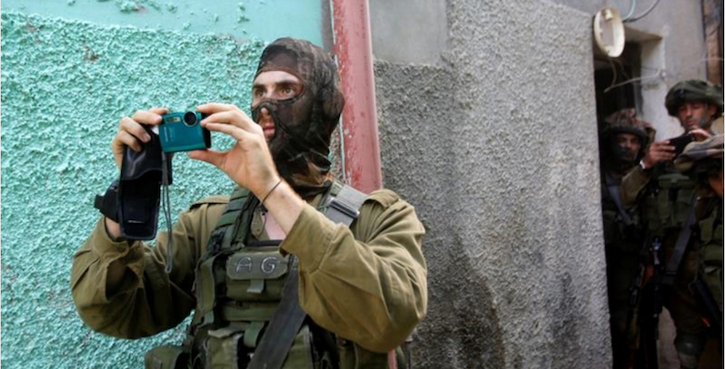 An Israeli army soldier films during a searching raid in the West Bank al-Fawwar refugee camp, south of Hebron. AL JAZEERA NEWS, “Israeli bill to ban filming soldiers on duty condemned,” May 28, 2018.”
An Israeli army soldier films during a searching raid in the West Bank al-Fawwar refugee camp, south of Hebron. AL JAZEERA NEWS, “Israeli bill to ban filming soldiers on duty condemned,” May 28, 2018.”
****
Media Mimicry
Media mimicry is adopted when more traditional strategies of image ban and censorship can no longer suffice to maintain events and incidents partially discreet. It is a tactic of obfuscation that recognizes the futile attempt to maintain secrecy in a highly visible environment in which visual media no longer pertains to technological superiority.{31} Media mimicry is shaped when the ruling power begins to imitate the ways in which dissidents employ filmmaking to document and distribute what the state desires to keep obscured.
This obfuscating strategy is demonstrated by another image that was recorded in Hebron, this time by an IDF soldier. In May of 2015, exactly a year before Elor Azaria shot Al-Sharif in Hebron, a much less spectacular incident unfolded at the very same junction, on the border with the Jewish settlement in the heart of the city. Abu-Haya, a Palestinian resident of the city, was having his lunch at home when he noticed a group of forty soldiers climbing up towards the rooftop of his house.{32} Accustomed to filming everyday life in Hebron, Abu-Haya picked up his video camera and begun filming the bewildering situation. What looked like a typical raid, took an unexpected twist when it turned out that the sole purpose of the sudden intrusion was to snap a photo on the rooftop of the house. One after the other, the Israeli soldiers climbed the stone steps around the house and congregated on the roof. All the while, Abu-Haya was recording their unsolicited activities and their unlikely meeting on his house. While posing for a group photograph, one soldier stepped forward with his mobile phone and snapped a single image: a group photograph.
Abu-Haya, “Hebron – Soldiers use Abu Hayas’ roof to pose for group photo,” May 26, 2015.
Resentful towards Abu-Haya’s practice of filmmaking and his collaboration with the NGO B’Tselem, the soldiers were there to claim back the mediascape and to demonstrate their reign and dominance over it. The snapshot taken by the soldiers is thus not the typical trophy photograph taken by soldiers who wish to boast their superior power. Unlike many other cases in which the trophy is the snapshot itself, here the claim over mediated space is a performance of domination over the cluster of gazes and visual media. This gesture, which concludes with a single and superfluous file, demonstrates the capacity to obfuscate the material produced by Abu-Haya, who aims his camera towards them. This gesture of snapping an image is aimed at defying the evidentiary mode of representation through conjuring multiple additional images that complicate, obscure, and fog a given document. “Obfuscation,” writes Helen Nissenbaum, “assumes that the signal can be spotted in some way and adds a plethora of related, similar, and pertinent signals—a crowd which an individual can mix, mingle, and, if only for a short time, hide.”{33} Dispensing with the representative value of the image itself, through this incident we enter into the realm of pure mediality, where images become data produced to blur and disorient.
Immunizing itself, the military must incorporate the substance that initially threatens its upper hand and control over visualization. This auto-immunitary process adopts the aesthetics of dissent to render them hollow. Israeli soldiers with mobile phones, for instance, rapidly produce low-resolution images, not merely to visually obfuscate (as I have mentioned already), but also as means of neutralizing the aesthetics of resistance, often conceived through the grainy, pixelated, and shaky footage, resonating with the Third Cinema manifesto, “For an Imperfect Cinema,” in which Juan García Espinosa calls for a blurring of roles and positions between consumer and producer, audience and author, high and low resolutions of images.{34} Hito Steyerl, in her celebrated essay “In Defense of the Poor Image,” draws a link between the low-resolution data-images that circulate online and the political impetus of Third Cinema.{35} On the one hand, Steyerl stressed, those low-resolution images that drift astray online have a certain kinship to the emancipation promised by Third Cinema; and on the other, the excess of data opens up new avenues to exercise power and eventually to centralize it. “The networks in which poor images circulate,” writes Steyerl, “constitute both a platform for a fragile new common interest and a battleground for commercial and national agendas.”{36} In this light, Steyerl redefines the value of the image, not only through resolution and exchange value, but and more crucially by “velocity, intensity, and spread.”{37} As they migrate and travel, the meaning of images shift and are displaced by their dematerialization and fluidity—a capacity today used and abused by the state actors.
****
Between the Exceptional and the Redundant
Finally, the militarized “family portrait” snapped in Hebron alludes to these nonrepresentational aspects of the image as data—made to circulate freely somewhere, perhaps never to resurface. This snapshot also brings me back to the video of the extrajudicial killing. Placed side by side, both media exemplify two distinct procedures aimed at diffusing the capacity of images to expose abuses of power by the state. On the one hand, the video of the killing in Hebron is isolated by the military as a potentially contaminating depiction of violence. By marking the video exceptional and the soldier as unruly, the IDF could have saved the military institution from contracting accountability. Shame, to use Thomas Keenan terms, is only a way of individualizing a structural criminal act, thus saving the system. On the other hand, the snapshot grabbed on the rooftop—more than a vandalizing provocation against the inhabitants of the occupied city of Hebron—is a symptom of an unofficial tactic of visual obfuscation that adds noise and confusion into the already flooded archives and databases. While the video of the killing in Hebron can blur the wider patterns of violence, which are less spectacular, the snapshot taken by the soldiers on the rooftop is about deflecting the attention and adding noise to an already saturated visual field.
The comparison between the two media—the video and the snapshot—sheds light on the ramification of ubiquitous media on everyday life in the Occupied Palestinian Territories. The snapshot is produced as a reaction to the ever-expanding pervasiveness of media that threatens the continuation of specific military procedures, while the video is the ultimate example of that threat. Both, however, appear on the same spectrum that stretches between the singularity of an event (the killing) and the inherent proliferation of media as part of the everyday in the Occupied Territories (the group photo). By gliding on this spectrum, the IDF can either deem a particularly unfavorable image as a singular instance, or increase the circulation of images to suffocate the incriminating potential within the bottomless pool of poor images. Both, however, are used flexibly to immunize the military system against visual evidence and to conceal the prevalent, and indeed daily, abuse of gun power underneath a cloak of images and data.
B’Tselem, “IDF Soldier Executes Wounded Palestinian man,” posted on YouTube, March 24, 2016
{1} Zitun, Yoav. “Soldier who shot neutralized terrorist is suspected of murder,” Ynet, late updated March 245, 2016, https://www.ynetnews.com/articles/0,7340,L-4783059,00.html. Last accessed 25 of March 2018.
{2} Based on an interview Ruthie Ginsburg conducted with Abu Shamsia in Hebron, December 2016.
11 אלאור אזריה המחט העיד כי לא הייתה הצדקה לירי במחבל כאן
לשעבר רשות השידור
{3} Thomas Keenan, “Mobilizing Shame,” South Atlantic Quarterly 103, no. 2/3 (Spring/Summer 2004): 435-49.
{4} Ibid.
{5} Shabtai Bendet, ”למשפט הוגן סקר: 43% מהציבור סבורים שאלאור אזריה לא זוכה ” {“Survey: 43 percent of the public Azaria was tried unjustly,”) Walla!, July 5, 2016, last accessed May 13, 2018, https://news.walla.co.il/item/2976259
{6} Israel Military Court, “Appeal Court Ruling Protocol,” May, 2017, 36, translated from the Hebrew by the author.
{7} Ibid., 40.
{8} Stuart Weiner, “Soldier Elor Azaria given 18 months in jail for killing wounded stabber,” Times of Israel, February 2017, p. 21, last accessed June 25, 2018.
{9} John Brown, “בררנית נגדו צוות ההגנה של אזריה משנה אסטרטגיה וטוען לאכיפה” (“The Defense Team are Changing Strategy and Claims for Selective Enforcement,”) Haaretz, last accessed April 2017,
{10} Ibid.
{11} According to Michal Tamir, the term “selective enforcement” applies to a situation in which even though the law seems fair and impartial, it is applied, administered, and enforced by the public authority in a discriminating way, in that the law is enforced only against certain individuals or groups, or in that there are different enforcement policies depending upon the identity or affiliation of the person or entity involved. Michal Tamir, “Public Law as a Whole: The Case of Selective Enforcement and Racial Profiling,” NYU Law School, 2015,
{12} “Open Fire Regulations” are the official instructions of the IDF dictating when, and in what circumstances, should a soldier can fire live ammunition. According to B’Tselem, “until the outbreak of the al- Aqsa Intifada in September 2000, the Open-Fire Regulations in the Occupied Territories were based on Israel’s penal code. Soldiers were only allowed to fire live ammunition when soldiers were in real and immediate life-threatening danger. When the 2000 intifada began, the IDF defined the events in the Occupied Territories as an armed conflict short of war,” and expanded the range of situations in which soldiers are permitted to open fire. “Trigger Happy: Unjustified Gunfire and the IDF’s Open-Fire Regulations during the al-Aqsa Intifada,” B’Tselem, March 2002.
{13} John Brown, “The Defense Team are Changing Strategy and Claims for Selective Enforcement.”
{14} Anne McClintock, “Paranoid Empire: Spectres from Guantanamo and Abu Ghraib,” Small Axe 13, no. 1 (March 2009): 50–74,
{15} Judith Butler, “Frames of War: When is Life Grievable?” (New York: Verso, 2009), 5, 13.
{16} For Butler, the context of the production of a visual document of war is at risk of being severed by its circulation: the circulation of images, pertinent to their visibility, can potentially destroy the context of their production. “The frame that seeks to contain, convey, and determine what is seen depends upon the conditions of circulability in order to succeed,” writes Butler, ibid., 11.
{17} Ibid.
{18} John Brown, “The Defense Team are Changing Strategy and Claims for Selective Enforcement.”
{19} Georges Didi-Huberman, Images In Spite of All: Four Photographs from Auschwitz (Chicago: Chicago University Press, 2008), 150.
{20} Ibid., 121.
{21} “The image is always an amalgam,” writes Didi-Huberman, “an impurity, visible things mixed with confused things, illusive things mixed with revealing things, visual forms mixed with a certain thought in action. It is therefore neither all nor nothing.” Ibid., 65.
{22} Hoskins and O’laughlin, War and the Media: After Diffused War (Cambridge, UK: Polity Press, 2010), 21.
{23} “The everyday, be this our connection with and our uses of media everyday,” writes Grusin, “are overlooked, given that they are routine and unexceptional and we do not ordinarily reflect upon such activities in themselves.” Richard Grusin Premediation: Affect and Mediality After 9\11 (New York: Palgrave and Macmillan, 2010), 27.
{24} Gershon Shafir, A Half Century of Occupation: Israel, Palestine, and the World’s Most Intractable Conflict (Berkeley: University of California Press, 2016).
{25} A dual legal system that separates between Palestinians in the West Bank and the Jewish settlers: Palestinians go to different courts; they fall under different rules of detention, search, and interrogation; their freedoms of expression, protest, and movement are constrained. By setting a legal system to which Palestinians are subjected to Israel has de facto created two laws for two peoples.
{26} Oren Yacobovich, “Shooting Back: The Israeli Human Rights Group B’Tselem Gives Palestinians Video Cameras to Document Life Under Occupation,” Democracy Now!, December 26, 2007.
{27} Ibid.
{28} “IDF’s ‘Documenting Warrior Project,’” Documenting Warrior Project, Elsight, last accessed June 28, 2018.
{29} Elsight provided the IDF Spokesman unit with a state of the art live video streaming system as part of the “Documenting Warrior Project,” designed to take close-up demonstrations moments, to facilitate image damage that may be caused to the IDF while dispersing demonstrations.
{30} Harriet Serwood, “Palestinian Children Woken in Night to be Photographed by Soldier,” Guardian, September 28, 2011.
{31} I employ the term obfuscation to unpack the ramification of habitual media on the exercise of security. Drawing on Helen Nissenbaum, visual obfuscation aims to further increase the flow of data and to bring it to the point of excess, derailing attention from a particular photograph or video. For Nissenbaum, obfuscation is the deliberate addition of ambiguous information for the purpose of interfering with data collection. “At its most abstract,” writes Nissenbaum, “obfuscation is the production of noise to make data more unintelligible, and therefore less valuable.” Helen Nissenbaum, Obfuscation: A User’s Guide to Privacy and Protest, (Cambridge, MA: MIT Press, 2015), 53.
{32} Yair Altman, “בחברון תיעוד: מה עשו 40 חיילים על גג בית משפחה פלסטינית?” (“Documentation: What did 40 Soldiers do on the Rooftop in Hebron?”) Walla!, May 29, 2015, https://news.walla.co.il/item/2858641
{33} Nissenbaum, Obfuscation, 53.
{34} Juan García Espinosa, “For an Imperfect Cinema,” trans. Julianne Burton, Jump Cut, no. 20 (1979): 24–26.
{35} Hito Steyerl, “In Defense of the Poor Image” e-flux, no. 10 (November 2009).
{36} Ibid.
{37} Ibid.


